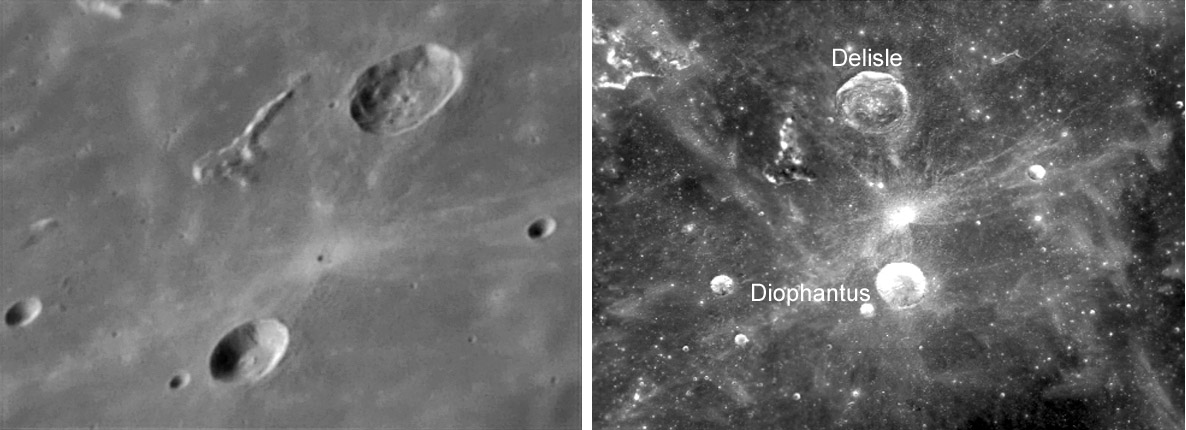November 5, 2017
A New Discovery?
Originally published April 29, 2008

images by (left) François Emond, Chorges, Hautes-Alpes, France and (right) Clementine (Map-A-Planet)
Once again the LPOD Photo Gallery has been the source of an image for LPOD. While approving a series of moderately high Sun views of the Imbrium area posted by François I noticed a feature of a small ray crater that I had previously overlooked. Between Delisle (diameter 25 km) and Diophantus (18 km) are two named craters: Samir (1.9 km) and Louise (0.7 km). A bright nimbus envelopes them both, raising the question which is the ray crater? The straight edge of the ray that passes toward Diophantus alerted me that there may be a zone of avoidance - where no rays were deposited - meaning that this would be an oblique impact crater. A quick look at the Clementine image on Map-A-Planet confirmed it. In fact, the edge of the ray field extends way past Diophantus and another edge is about at right angles, with darker, un-rayed mare between. The zone of avoidance edges converge on Samir so that it the ray crater. Note also that Samir's rays extend only at right angles to the direction of the avoidance zone apex. This means that the impact angle was very low, creating a butterfly pattern of ejecta similar to that of Messier. Remarkably, Samir is not an elongated crater like Messier. Its also remarkable that the straight edge of the ray pattern on François' image alerted me to the oblique origin and then to the solution as to which is the ray crater. A useful image!
Chuck Wood
Technical Details
10/03/07 ; 03h52 UT. Dobson 16" + FFC Barlow lens + webcam Vesta Pro (B & W, raw mode) + red filter.
Related Links
Rükl plate 19
François' website
Yesterday's LPOD: Changes?
Tomorrow's LPOD: Was I Wrong?
COMMENTS
(1) Just a thought Chuck. I'm wondering as Loiuse is probably the older of the two craters (because ray material from Samir seems to cover it), did possible formation of a small raised rim around Louise affect the direction in which material from Samir could go? If this was so, would this mean that Samir's formation (and its lack of elongation) may not have involved as low an impact-angle impactor that it suggests? I'm thinking, however, that small craters, like Louise, may not produce an appreciable rim height that would affect (block) the direction of ejecta when closely-related craters like these are involved.
John -- www.moonposter.ie
(2) An interesting idea, John, but I don't think it is right. You can just glimpse Louise in François' image but to see it in the Clementine you need to go to Map-A-Planet and make a strong enlargement of the area. If you do, you'll see that Lousie is off to the side of where the avoidance apex is. And as you say its rim is very low so it may not have had much of an effect anyway. I looked closely to determine if Louise is older than Samir but I couldn't decide.
--Chuck
(3) Thanks Chuck. "Lunar Orbiter" image LO4-139H1 in that wondeful atlas of the same does show both craters very nicely, but as the apex isn't very clear, I will definitely check out Map-A-Planet (new to me) as you suggest. Also, I appreciate your taking time to answer these, sometimes, stupid questions that I (and others???) throw at you -- but, that's what you get for being a wonderful source and wealth of information about the Moon :-)) John -- www.moonposter.ie
(4) If you'd like to hear a truely stupid question then I have one (John, nothing wrong with any of your questions, Sir ;)). I'm having difficulty appreciating the mechanism that gave rise to the curved ray that defines the 'east-west' border to the area of avoidance in Samir's ejecta blanket above (to me the rays that define this area that pass through Diophantus (north-south) appear straighter). Am I imagining it or are there other fine examples of these curved rays?... I can't seem to detect any 'arcs' in Messier A and B's butterfly rays as they appear straighter. Forgive my ignorance.
Mark
(5) Mark - I wish your question was stupid, but its not. I don't know why its curved - the Proclus rays are straight...
--Chuck
COMMENTS?
Register, Log in, and join in the comments.



